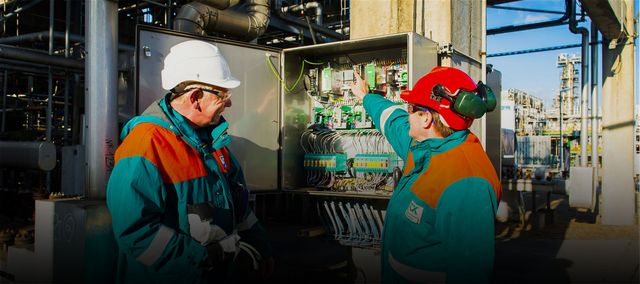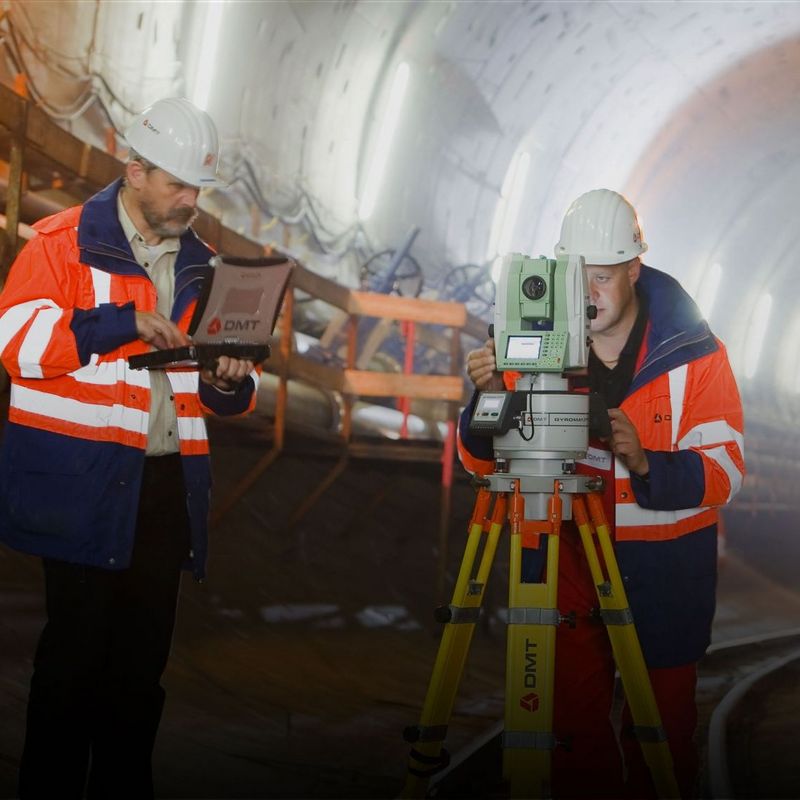8 September 2016
Large industrial plants should run for many years, safely and free of defects. Operational breakdowns are expensive and potentially even dangerous. Condition monitoring systems (CMS) from DMT can prevent outages and reduce costs.
Anyone approaching the PCK Raffinerie in Schwedt in the Uckermark late at night is treated to an impressive panorama. A network of tubes and pumps, boilers, chimneys and columns, whose function is totally impenetrable to the layman, extends over several square kilometres and is surrounded by fields. In countless places the refinery is illuminated by thousands of spotlights, offering a fascinating sight. Alone the gigantic dimensions of the plant are impressive. Here the principal fuel of the industrial age – crude oil – is processed. 24 hours a day, all year round. Every year, processing products without which life as we know it would be impossible, such as petrol, diesel, fuel oils, LPG, bitumen and various other substances, are made here from some twelve million tonnes of crude oil. This makes the PCK Raffinerie one of the largest crude oil processing sites in Germany. The smooth running of refineries like the PCK in Schwedt is one of the most crucial conditions for the functioning of other industries, which would be completely crippled without refinery products – as would the vehicles we require for mobility.
Without fuel, everything on roads and rails and at airports would grind to a halt. Given the huge size of this industrial plant, the question arises as to how on earth the system and its parts are supposed to be monitored. How can this seemingly impenetrable thicket of plant be monitored; how can damage be discovered in time and fixed? One important part of the refinery is the thousands of pumps that move the crude oil and its products over many kilometres. It only takes one to fail for problems to start. And yet, there is good news: The impending failure of a pump usually announces itself some way in advance; what is required, however, is the ability to interpret the signs properly. And this is exactly where DMT comes into play.
“With our early-warning damage detection system we can receive signals in good time that indicate future problems.”
“Most damage generally occurs gradually over time,” explains Michael Wölfle, Head of the Machine Diagnosis field at DMT. “But if structural components fail all of a sudden, this can be very time-consuming and costly, especially when you don‘t know exactly what has caused the failure. With our early damage detection system we can receive signals that indicate future problems well before the failure actually happens.” The procedure is known as “condition-oriented maintenance.” What is used here is a condition monitoring system (CMS) with which the monitoring of plants can largely be automated. DMT offers its customers complete solutions; the company supplies special measurement hardware and modern database and web-based software; it also offers installation and commissioning, including engineering, consultancy work and the training of employees.
“As a modern refinery, PCK uses the DMT monitoring system to ensure high levels of availability of its machines and structural components.”
At PCK, DMT supplied the necessary instrumentation and trained the technicians on site. They can now monitor the entire system themselves. “As a modern refinery, PCK ensures the high availability of its machines and structural components with the aid of the DMT monitoring system. The early warning system is appreciated for its reliability and ease of use,” explains Frank Stargardt, section head of Maintenance, Contractor Supervision and Services at PCK. Smaller companies for which the cost of carrying out their own monitoring would be prohibitive can use the DMT control centre in Essen.
Structure-borne sound measurements
But how does the condition monitoring system work in a refinery like PCK, for instance? First of all, agreement must be reached with the customer on the exact monitoring needs. “In a refinery this represents about ten percent of the structural components,” says Wölfle. The next step involves determining where and how many of the measuring instruments are to be used. These instruments are known as structure- borne sound sensors. The values measured are transmitted via cables to the server on which the plant data and the evaluation software are located. If the data deviate from the defined target data, the software raises the alarm. Then the operators can immediately find a remedy without causing an unscheduled outage.
Every year sees new refineries with CMS
“Of course there’s no way of completely avoiding a shutdown, even with condition monitoring. Audits have to take place – it’s the law. However, the operator can schedule the closure of either a single range of components or the entire plant,” says Wölfle. “The advantages are obvious: lower maintenance costs, smooth operation and high levels of plant availability. This saves both time and money.” Word of the system’s success at PCK has spread. “We’ve equipped two more refineries in Germany with several CMS.” Another important field of application is in mines. DMT has for instance equipped coal mines from Australia to the United States with condition monitoring systems. And the DMT hardware and software is used also in wind farms. With an operating temperature range of –40° to +65° C, the hardware can be used in harsh environments.
YOU MAY ALSO LIKE
 Gorodenkoff Productions / AdobeStock
Gorodenkoff Productions / AdobeStockWhat does ISO 9001:2015 mean?
Quality and customer satisfaction are the decisive criteria for the success of a company.
Read more
IN THE AIR AND UNDERGROUND
Mining
With its condition monitoring system, DMT is making a contribution to the economic processes and procedures of operators of mining machinery. The measuring system proves its worth on machines working under the harsh ambient conditions of the coal face just as effectively as it does with the bottleneck systems in the infrastructure of a mine. These include in particular the conveyor belt systems on which the products of, in most cases, a number of operating points are transported.
Wind energy
Thanks to the condition monitoring system, the operators of wind farms always have an overview of the condition of their plants. They can schedule required repairs several months in advance. This contributes directly to the profitability of investments, as expensive consequential damages and unscheduled downtime are reducible to a minimum.
TWO DECADES OF EXPERIENCE
DMT has over 20 years of experience in the development and application of condition monitoring systems. These are used in large-scale applications with thousands of monitored structural components. Typical industries include petro- chemicals, power plants and metal production (PlantSafe), mining (MineSafe), petroleum and natural gas (RigSafe), and wind power (WindSafe).
Where is the expense of the condition monitoring system justified?
The expense of the condition monitoring system is justified wherever equipment is very expensive, difficult to reach or relevant to production: that is to say, where the failure of one small component can bring an entire production facility to a standstill. This is the case, for instance, with conveyor belts in mines, which, if they were to break down, would bring the entire production to a grinding halt.
XSafe system
Another new product from DMT is the new, modular XSafe system which is highly versatile and adaptable. If, however, an application-specific method is required, DMT will develop a fitting solution and adapt the hard- and software to the environment in question. This applies also to deployments in areas where the conditions are harsh or there is a risk of explosion.



